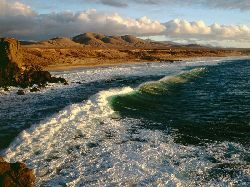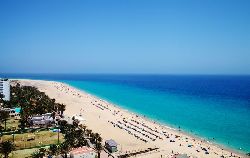Common description
Fuerteventura is the second largest island of the Canary archipelago after Tenerife, an island of sunshine and tranquility. Like the surrounding islands, it is volcanic in origin. Fuerteventura is believed to be the oldest island in the Canary archipelago, formed by volcanic eruptions many millennia ago.
Fuerteventura lacks numerous clubs and discos, making it an alternative to the surrounding youth and party resorts. This island is a place for quiet and secluded family holidays, as well as a favorite gathering place for surfers from all over the world.
The main resorts are Costa Calmi, Morro del Jable and Playa Matroral, located on the peninsula of Chandia, as well as Caleta del Fustes and Playa de Corralejo.
You can reach Fuerteventura by plane from Madrid or Barcelona, as well as from the island of Tenerife. There is a sea and air connection between Fuerteventura and the other Canary Islands. You can travel around the island by bus, use a taxi or rent a car.
The beach season on the island lasts all year. The average July temperature is + 27 ° C, in January - about +20 ° C. The water temperature in the ocean year round is +20 ° C. Feature of Fuerteventura is a constant breeze that makes the climate on the island is much softer than located near the coast of Africa.
There are dozens of beaches on Fuerteventura . The northern and western beaches of Corallejo, Coffey and Barlovento are less developed due to the constant winds and popular with windsurfers.
To the east of the island lies the longest beach in the island of Sotavento, whose coastline reaches 30 km. In fact, it consists of several smaller beaches: Matorana, Boutihondo and Sotavento itself. The World Windsurfing Championship is held annually in July and August, and the Strait between Lobos and Fuerteventura is a great place for diving. Deep sea fishing and sea fishing are offered in the Playa de Corralejo and Morro del Hable.
In the south of the island are the sandy beach of Juan Gomez, the beach with pebble black volcanic rocks La Parede and the long beach with golden sand Vella Rey. Nudism is allowed on all these beaches.
Fuerteventura lacks numerous clubs and discos, making it an alternative to the surrounding youth and party resorts. This island is a place for quiet and secluded family holidays, as well as a favorite gathering place for surfers from all over the world.
The main resorts are Costa Calmi, Morro del Jable and Playa Matroral, located on the peninsula of Chandia, as well as Caleta del Fustes and Playa de Corralejo.
You can reach Fuerteventura by plane from Madrid or Barcelona, as well as from the island of Tenerife. There is a sea and air connection between Fuerteventura and the other Canary Islands. You can travel around the island by bus, use a taxi or rent a car.
The beach season on the island lasts all year. The average July temperature is + 27 ° C, in January - about +20 ° C. The water temperature in the ocean year round is +20 ° C. Feature of Fuerteventura is a constant breeze that makes the climate on the island is much softer than located near the coast of Africa.
There are dozens of beaches on Fuerteventura . The northern and western beaches of Corallejo, Coffey and Barlovento are less developed due to the constant winds and popular with windsurfers.
To the east of the island lies the longest beach in the island of Sotavento, whose coastline reaches 30 km. In fact, it consists of several smaller beaches: Matorana, Boutihondo and Sotavento itself. The World Windsurfing Championship is held annually in July and August, and the Strait between Lobos and Fuerteventura is a great place for diving. Deep sea fishing and sea fishing are offered in the Playa de Corralejo and Morro del Hable.
In the south of the island are the sandy beach of Juan Gomez, the beach with pebble black volcanic rocks La Parede and the long beach with golden sand Vella Rey. Nudism is allowed on all these beaches.





